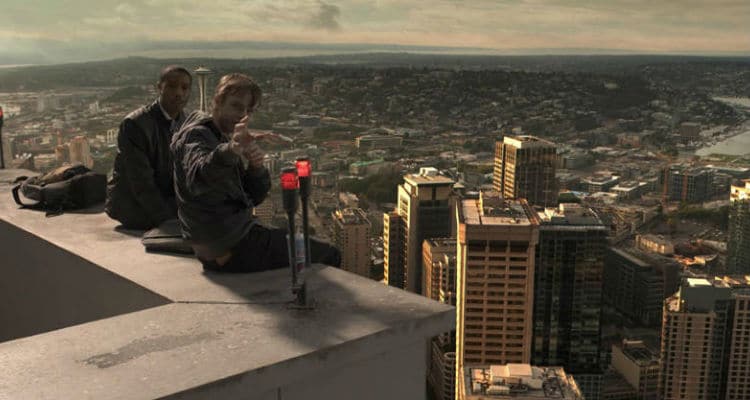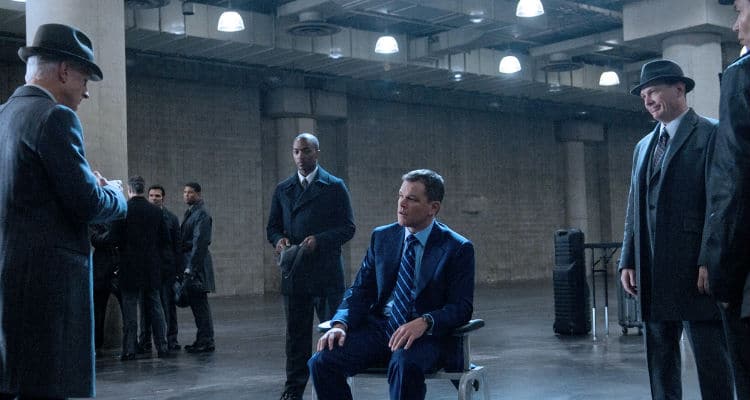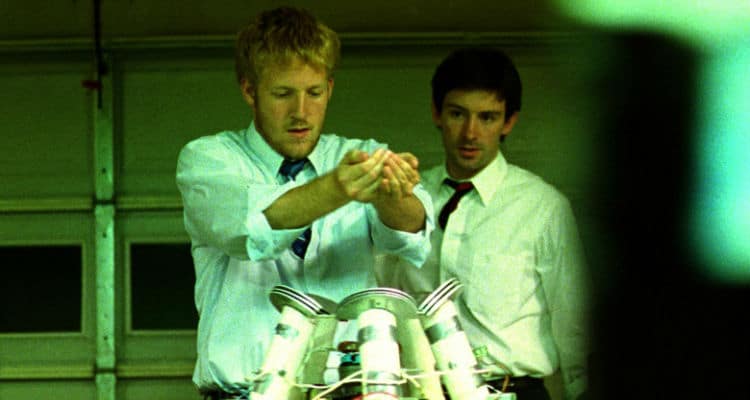Thriller Screenplay Power
As a genre, ‘thriller’ tends to gently caress several others, namely horror, sci-fi, and drama. As such, thriller screenplays provide a goldmine of various narrative and structural techniques.
western“>These may well be films you’ve seen; it’s just that some of them might not have left you desperate to read on the page. Nonetheless, each has something to offer any writer.
western“>Here are ten thriller screenplays you may not have read, but should…
PRIMER
western“>Probably the least well-known of the thriller screenplays on this list, this low budget sci-fi thriller from 2004 has a plot so tangled most people need a diagram to unravel it, but that’s exactly what makes it impressive.
western“>After working on their matter-reduction device leads them to accidentally discover time travel, friends Aaron and Abe experiment with the results in an insane criss-cross of time loops.
western“>The particular nature of the time travel is what makes this script interesting. The device must be turned on at the point to which you wish to go back, so that when you enter it how ever many hours later, you are taken back to that moment.
western“>The original ‘you’ is therefore pure, always destined to get into the box and then… cease to exist. This results in a slew of doubles and crossed timelines, and versions of both Abe and Aaron choosing to avoid or interfere with their originals respectively.
western“>”I’m not into the whole ‘destiny, there’s-only-one-right-way thing’.”
western“>The interesting choice writer Sean Carruth makes is in keeping the dialogue, and by extension story, relatively opaque. This allows the dialogue to feel more natural (no overly expository explanation of scientific terms, and no one using the line ‘In English, please?’) and allows the focus to stay more on the philosophical and moral implications of time travel than the logistics themselves.
UNBREAKABLE
western“>M. Night Shyamalan (not necessarily a name you’d expect on a ‘thriller screenplays you should read’ list) was as lauded for THE SIXTH SENSE as he is criticised for everything that’s not THE SIXTH SENSE, but UNBREAKABLE is a film that, ironically, breaks that mould.
western“>It centres on David, the miraculous sole survivor of an horrific train crash, and Elijah, a man who thinks David might have some superheroic ability that saved him.
western“>The film stands apart in a now crowded genre by eschewing any kind of cataclysmic showdown and instead focusing on a man unsure of who and what he is. Though David does display some potentially ‘super’ abilities, the story is kept vague enough that whether or not he’s actually superhuman isn’t entirely clear until later on, and he is in a perpetual crisis of faith for exactly that reason.
western“>A great example is the subversion in the scene in which David and his young son try to test his strength. He lifts progressively heavier weights, astounding both himself and Jeremy, but rather than building to the superpowered triumph you might see in other superhero origin stories (Spiderman finally managing to webswing; Iron Man managing to fly etc.) he casts doubt over what we’ve just seen:
western“>”There are big guys in every gym who can lift that much.”
SOURCE CODE
western“>The second film from director Duncan Jones sees a soldier, Colter Stevens, sent into the residual consciousness of a dead man to repeatedly relive the last seven minutes before a terrorist attack until he can discover its perpetrator.
western“>From a screenwriting standpoint, it’s interesting to note the importance of establishing detail in a repetitive narrative like this. Most screenplays use the idea of a set-up and pay-off, establishing some fact, some facet of character or environment early on that will play an important role later.
western“> When your narrative comprises the same seven minutes on repeat, this dynamic changes, so pay-off actually comes from re-contextualising the same moment in different ways. Writer Ben Ripley is careful to give enough detail in those seven minutes that each part of the scene can be re-purposed later on based on what Stevens has learned.
western“>The coffee spill, coke can, and woman walking past, for example, are details later used to demonstrate Stevens adapting to the repetition, while the nervous man stepping out of the bathroom, student checking his bag, businessman on the phone are all re-contextualised as suspicious once Stevens knows what his goal is.
SHALLOW GRAVE
western“>Danny Boyle’s first film, with a screenplay by John Hodge, centres around three flatmates who find their newly-moved-in fourth dead in his room, alongside a suitcase full of money. The film follows the breakdown of their friendship as they fight over what to do with it.
western“>This one’s worth a read for the opening alone, a montage of interviews the friends conduct with potential new flatmates. Each character is deftly set up through the way they conduct themselves when asking questions: Alex as cocky and sarcastic; David as anally retentive and socially distant; Juliet as intelligent but prickly.
western“>”So tell me, Cameron, just tell me because I’d like to know, what on earth would make you think that we’d want to share a flat like this with someone like you?”
western“>Hodge manages to endear us to three honestly quite horrible people while making us aware of the potential for fracture in their relationship and setting up the story with the arrival of their chosen newcomer. It’s an impressive amount to cover and in a genuinely funny scene.
CHRONICLE
western“>Max Landis and Josh Trank’s unique take on the superhero genre sees protagonist Andrew decide to film his day-to-day life to keep tabs on his abusive father. However, what he captures instead is he, his cousin Matt their friend Steve discovering a mysterious cave in which they encounter a crystalline substance which gives them powers.
western“>”I bought a camera. I’m filming all your s*** from now on.”
western“>As a found footage film, this stands apart from the other thriller screenplays on this list, and the overarching set-up and pay-off in the film’s form is worth looking at. As stated, the reason the film exists at all (in its own internal logic) is that Andrew wants to document his father’s actions, something which is seemingly dropped as the superpower element enters into the narrative.
western“>
western“>However, once Andrew has honed his power and grown over-zealous, Landis brings the father back to help illustrate Andrew’s growing aggression, and then once again as the catalyst for the final showdown. Andrew’s cousin must try to stop him killing his father, whom he blames for his mother’s death.
western“>It’s a clever plot point. Found footage films are often burdened by having to explain their own existence (why are they filming this?), which often leads to some throwaway explanation like ‘I’m making a documentary about myself’; ‘I thought it would be fun’; or ‘I’m just hoping that, at some point, someone with dignity will fall over so I can relive its loss in slo-mo’. That it proves a major part of CHRONICLE’s structure sets it apart.
western“>Andrew’s arc from bullied outsider to bully himself is also a well realised one, taking an empathetic character picked on by others and turning him worse than they ever were once he realises he has the upper hand.
MOON
western“>Another by Duncan Jones, MOON is set on a lunar base with a sole occupant: Sam Bell. Bell is responsible for operating and maintaining a mining facility, a job he does alone.
western“>”You’ve been up here too long, man. You’ve lost your marbles.”
western“>The story hinges on the mid-point reveal that Sam is not in fact alone, but one of a series of clones that serve at the base one after the other. It’s a twist large enough to conclude a film, but writers Nathan Parker and Jones himself focus instead on the aftermath of the realisation, with two Sams coming to terms with the fact that they aren’t the original.
THE PRESTIGE
western“>Christopher Nolan’s 2006 film tells the story of two rival magicians in London during the early 20th century, making it the only of the thriller screenplays on this list to adopt a period setting. The screenplay uses fractured narrative, which, if poorly structured, can be a confusing mess. Here, it works really well, specifically in Nolan’s use of a kind of ‘question and answer’ structure in the story.
western“>Mysteries in the future are solved by scenes set in the past and vice versa. For example, the field of top hats or Angier’s use of a cane are explained in the past, while Borden’s apparent ability to be in two places at once is explained in the future.
western“>Everything is set up to keep the audience guessing, putting them in the right frame of mind for the overarching mystery to have the desired effect. This structural balance makes it well worth reading.
BLOOD SIMPLE
western“>One of two thriller screenplays in the Coen’s body of work, their first film is markedly different in tone from some of their later work. You could say BLOOD SIMPLE came before they’d really ‘found their voice’, but either way the film is masterfully structured.
The film centres on lovers Abby and Ray, Abby’s husband Marty and private detective Loren Visser, and the notable thing about the way in which the story is structured is that every single plan by every single character goes wrong, each of which causes a huge misunderstanding which in turn leads to more failure. It’s a Shakespeare play of thriller screenplays.
Dramatic irony plagues all four main characters, and each of their misguided perspectives helps feed the confused tension that grows between them. If there’s one scene worth looking at, it’s the final one in Abby’s apartment, in which the tension reaches a head and, in a cruel burst of black humour, Visser realises that all the awful things that have gone before must have been misguided mistakes rather than careful planning.
Cleverly, the whole scene plays out without Abby realising who it is that’s come to her apartment, always keeping her at enough of a distance to maintain the confusion right up to the final moments.
THE ADJUSTMENT BUREAU
Despite a title that implies using a spirit level to straighten a dresser, THE ADJUSTMENT BUREAU centres on a shady supernatural organisation that, appropriately, ‘adjusts’ the course of earthly events in line with some cosmic plan. Our protagonist (the third David on this list, because Bible) is a politician who’s just lost his campaign for senate when he meets Elise, an encounter that sets his plan off course and gets the bureau involved.
Though not necessarily one that epitomises thriller screenplays, the stand-out scene is the concession speech David gives right after their initial meeting, and it’s interesting to note how the scene changes from draft to screen.

Initially, screenwriter George Nolfi has David double down on his man-of-the-people honesty and charm, giving a heartfelt account of his childhood and tragic past. The final version goes the opposite way, having David speak candidly about the visual and rhetorical tricks (scuffed shoes, made up home town sayings) he has used to convince supporters of his legitimacy.
The second version works far better in emphasising the importance of his meeting with Elise. In the first, their meeting inspires him to give a good speech, a speech he would have given anyway, but better. In the second, he is more reckless, realising that he’s willing to risk his political standing if it means he can stay honest.
It’s a small scene, but the effect it has retrospectively on the ‘inciting incident’ is crucial. The change allows for this chance encounter to seem more significant, better supporting the conflict between his blossoming political career and his infatuation with her that runs through the film.
CUBE
Six seemingly unconnected people find themselves trapped in a network of cubic rooms, some fitted with deadly traps. None know why they are there, but they must put their heads together to find their way out alive.
Of the thriller screenplays on this list, this is the one that errs closest to horror, and it’s worth reading for the interplay between its core group.
Admittedly, the characters are archetypical, but the clever storytelling comes in their varying approaches to the problems at hand, and the ways in which the writers subvert expectation: the renowned escapist dying first; the archetypically rational doctor actually being a conspiracy theorist; the autistic character proving to be both liability and saviour.
The most effectively realised aspect of the characters is the confidence each one has when they think they’ve noticed a pattern. Seeing order in their apparently random predicament brings them comfort and hope, but often the patterns they find are just coincidence.
It also seems quite true to life: if you ever tackled a puzzle co-op you’ll know how strongly people come to believe in their own notions about the solution, though, to be fair, crosswords rarely include ceiling knives.
– What did you think of this article? Share It, Like It, give it a rating, and let us know your thoughts in the comments box further down…
– Struggling with a script or book? Story analysis is what we do, all day, every day… check out our range of services for writers & filmmakers here.
Get *ALL* our FREE Resources
Tackle the trickiest areas of screenwriting with our exclusive eBooks. Get all our FREE resources when you join 60,000 filmmakers on our mailing list!

